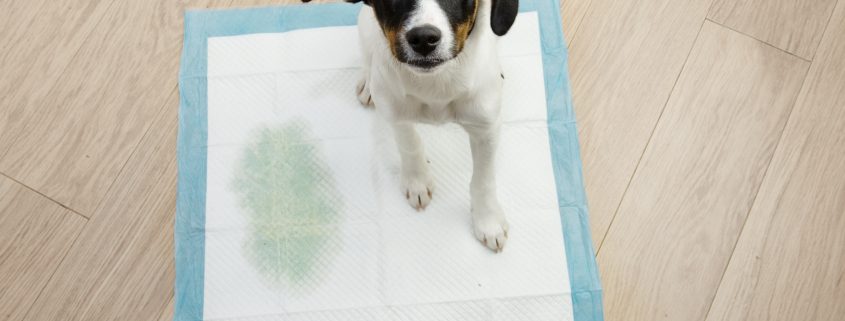Housebreaking, house-training, or potty training— no matter what you call it, all new dog owners need to teach their new puppy not to relieve themselves inside the home. Learning how to potty train puppies is one of the most important first steps you can take for a long, happy life together. House soiling is among the top reasons why dogs end up in shelters. Few people are willing to put up with a dog who destroys carpets, flooring and rugs, or who repeatedly leaves messes that have to be cleaned up over and over. The good news is there are tried-and-true methods for training your puppy once you bring them home, and in this blog we explore some of these methods in depth.
Stick to a Schedule
Each day begins the same for you and your puppy. When the alarm clock goes off, wake up and immediately take your puppy outside to do their business. Don’t stop to make coffee, check emails, or brush your teeth – not taking them out right away can lead to an accident on the floor.
Another morning ritual will be breakfast. After you take your puppy out to potty, they will be ready for their first meal of the day. Try to keep this scheduled at the same time each day. This will help with regulating their potty schedule and serve as an easy reminder for you as well. After the meal, wait between 15 and 20 minutes to take your puppy outside. As the puppy grows older, they will gain bladder/bowel control and learn to hold it longer each day.
There are many other times that a young puppy will need to go potty, besides the first thing in the morning and after each meal. These instances include after naps and playtime. Naps are mini-versions of the morning routine. Make sure that whenever your puppy is sleeping, you take them outside the moment they wake up. During playtime, the stimulation of the digestive tract may also give your pup the urge to have a potty break. So, after a game of tug or fetch, take your puppy out to potty immediately.
Supervise, Supervise, Supervise!
As with human babies, canine potty habits are highly idiosyncratic. Some will have to go out every time they play or get excited. Some will stop in the middle of a play session, pee, and play on. This is why you have to watch your puppy carefully for individual signals and rhythms. Learning signals that indicate your puppy needs to go potty will prevent unnecessary accidents in the house. Most dogs will sniff, make circles, wander off, or whine to indicate they need to go to the bathroom.
Potty Training Tools
Crates – Many puppy parents cringe at the idea of confining their puppies in a crate, but crates make life—and potty training—much easier. The principle behind using a crate for housetraining is that dogs don’t like soiling their sleeping space. Make sure your puppy’s crate is sized with just enough space for them to turn around and lie down comfortably, but no excess space that allows them to have a sleeping area and a potty area. When your crated puppy feels the urge, they will signal that they have to go and want out of their crate. When this happens, don’t delay! If you let your pup have an accident in their crate, they’ll get the idea that it’s okay and continue to do it.
Puppy pads – The use of puppy pads can be tricky because you’re reinforcing two different bathroom options for your puppy. In an ideal situation, pups would learn to hold it indoors and only go potty outdoors. But some cases may require a bit of creative thought, such as a person who has a job that makes it impossible to get home several times a day, or for a dog living where the winters are too brutal for pottying outside. Then, after your puppy matures you can then work on getting rid of puppy pads and having your dog do their business outside all the time.
Positive reinforcement – Your reaction to your puppy when they potty where they are supposed to—and when they don’t—could make or break the potty training experience for your pup. When your dog does their business outside as they are supposed to, be sure to reinforce this behavior with plenty of praise, pets, and a low-calorie treat. And if your puppy does have an accident inside the house, do not rub their nose in it, spank them, or yell at them. This teaches your dog to fear you and they may hide when they need to “go” instead of coming to you and telling you. Instead, take them outside immediately when you discover the accident, take a deep breath, and stay the course.
Extra Tips
Go often – Take your pup out first thing in the morning, after all feedings, and anytime you see signals that they might need to go. Here are some general rules about how long puppies can “hold it” based on their age:
- 2-month-old pups must potty every two hours
- 3-month-olds can wait four hours
- 4-month-olds need a break after five hours
- 5-month-olds can hold it for about six hours
Keep in mind these are not hard and fast rules. At 5-months-old, a large-breed dog shouldn’t have any trouble holding their bladder for up to six hours, however, a toy or small breed dog may not have this ability simply because they have a tiny bladder.
Monitor water intake – If your puppy is a heavy water drinker, chances are they’ll urinate frequently as well. To prevent any accidents, take your puppy out shortly after drinking so they’re in the right place at the right time.
Have patience – Some puppies have perfect manners after just a few days, while others can take months. By scheduling meals, walks, playtime, and other activities and keeping a daily routine, you and your pup will be on your way to success. Just keep in mind it won’t happen overnight. The key to successful potty training patience, persistence, and positive reinforcement!
Your Pets are our Priority!
At the National Animal Supplement Council (NASC), our number one priority is to promote the health and wellbeing of your pets. That is why we created the NASC Audit Program and the Quality Seal, which helps you identify animal health and nutritional supplements that come from responsible suppliers committed to producing the highest quality, most consistent products available. Visit our website to learn more and to see a list of NASC members that have earned the Quality Seal.

